Unit 1 A land of diversity integrating skills (i)
文档属性
| 名称 | Unit 1 A land of diversity integrating skills (i) | 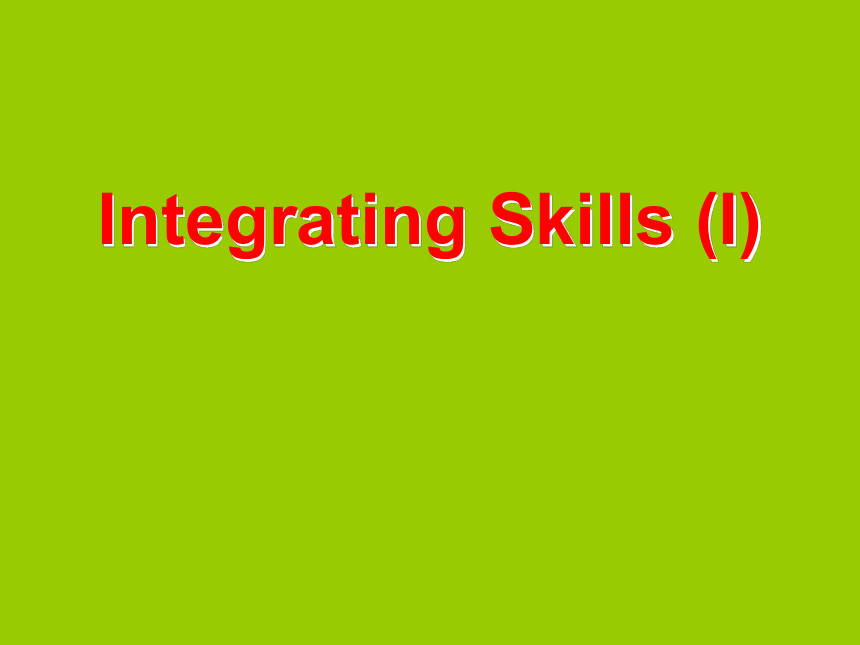 | |
| 格式 | rar | ||
| 文件大小 | 2.3MB | ||
| 资源类型 | 教案 | ||
| 版本资源 | 人教版(新课程标准) | ||
| 科目 | 英语 | ||
| 更新时间 | 2010-08-10 12:23:00 | ||
图片预览

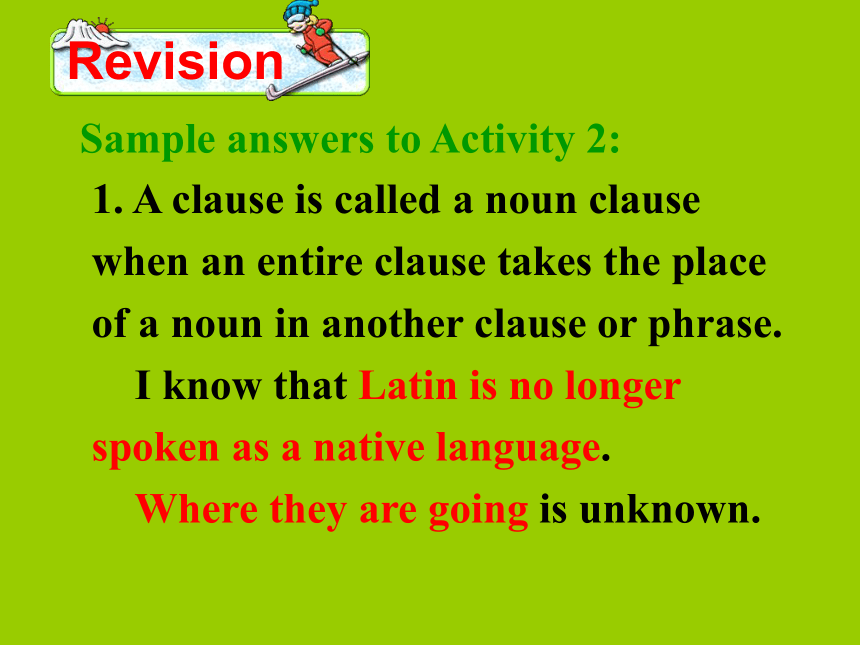
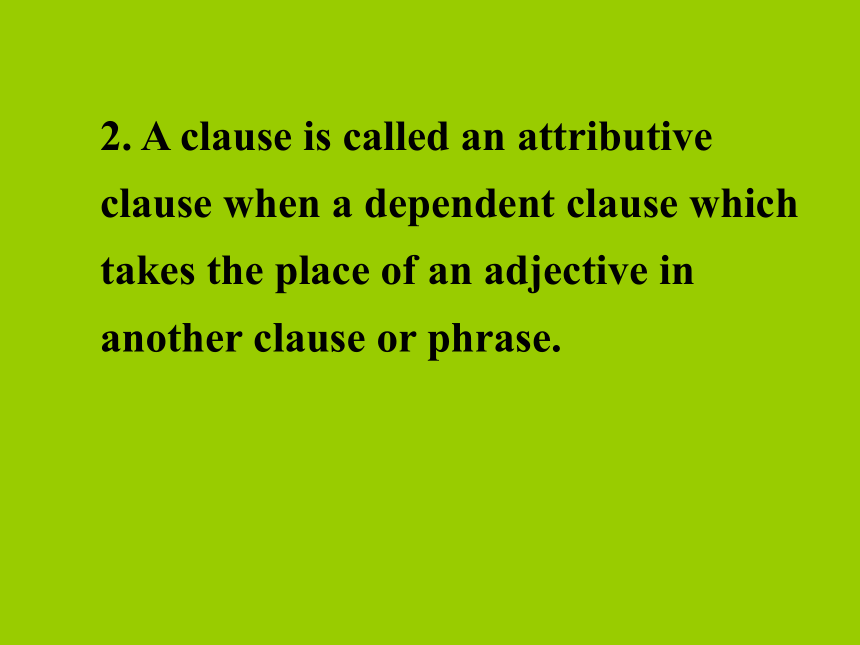
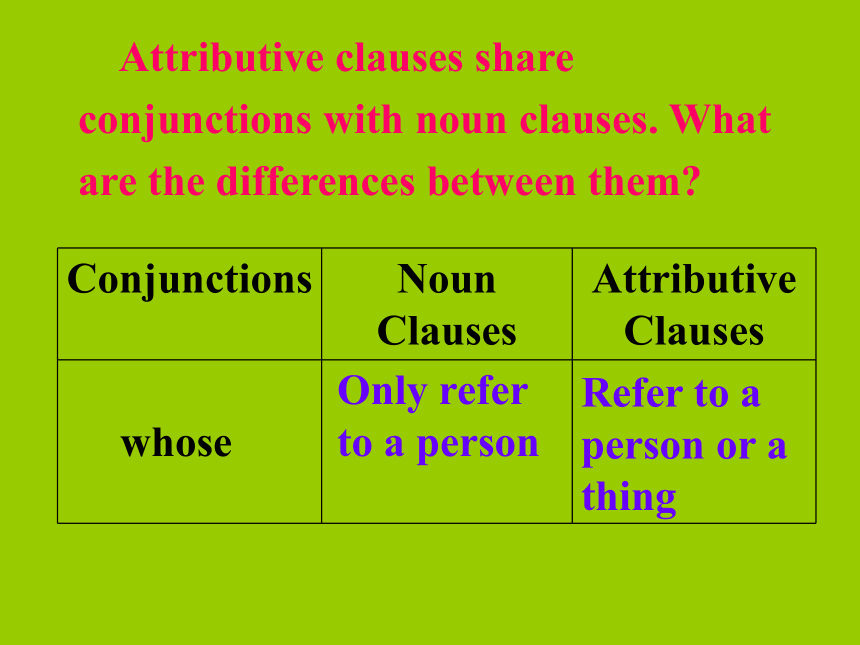
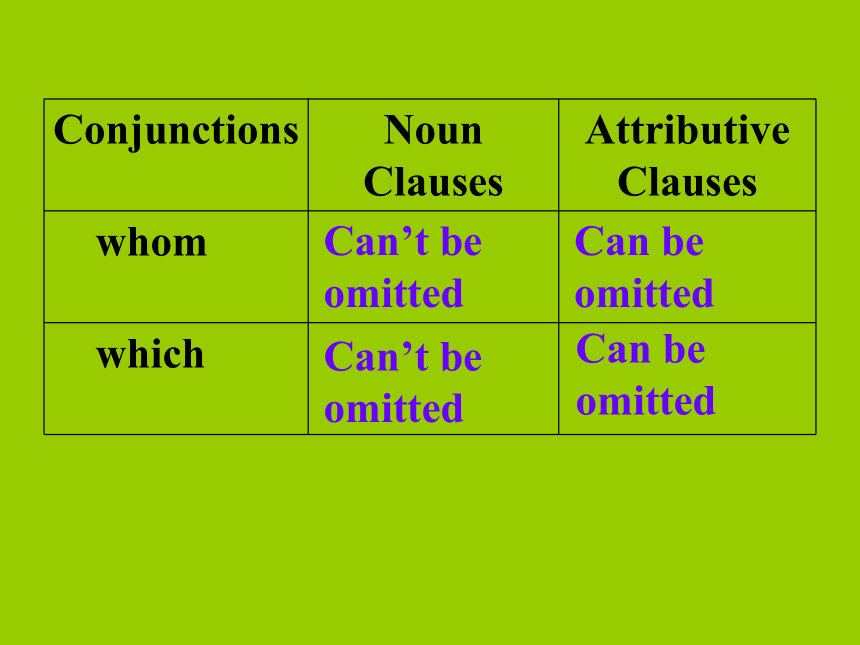
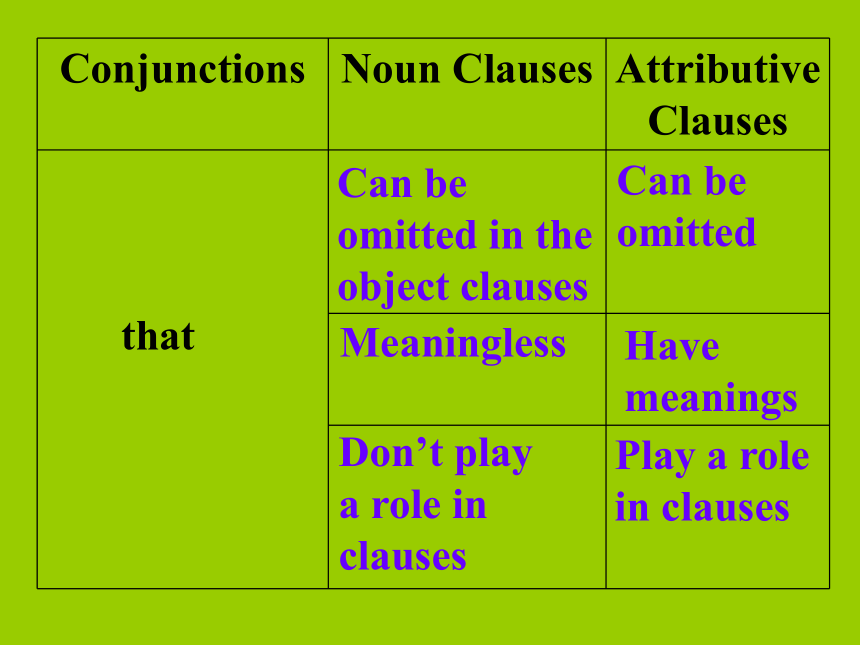
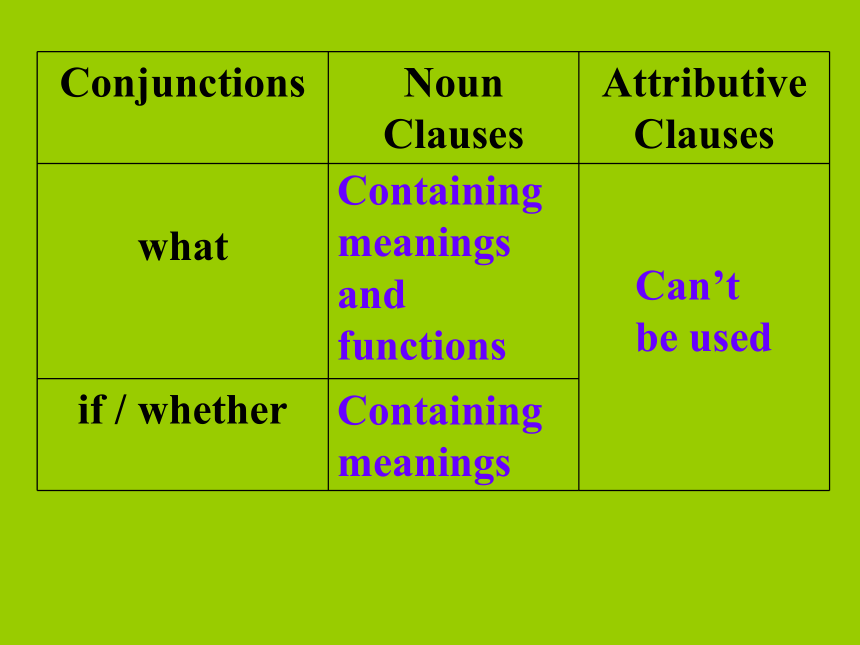
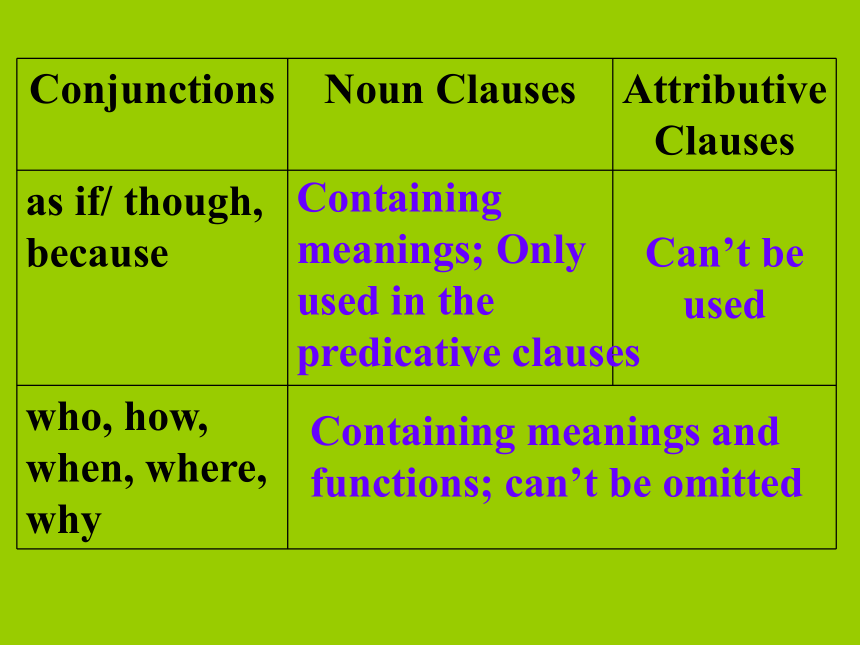
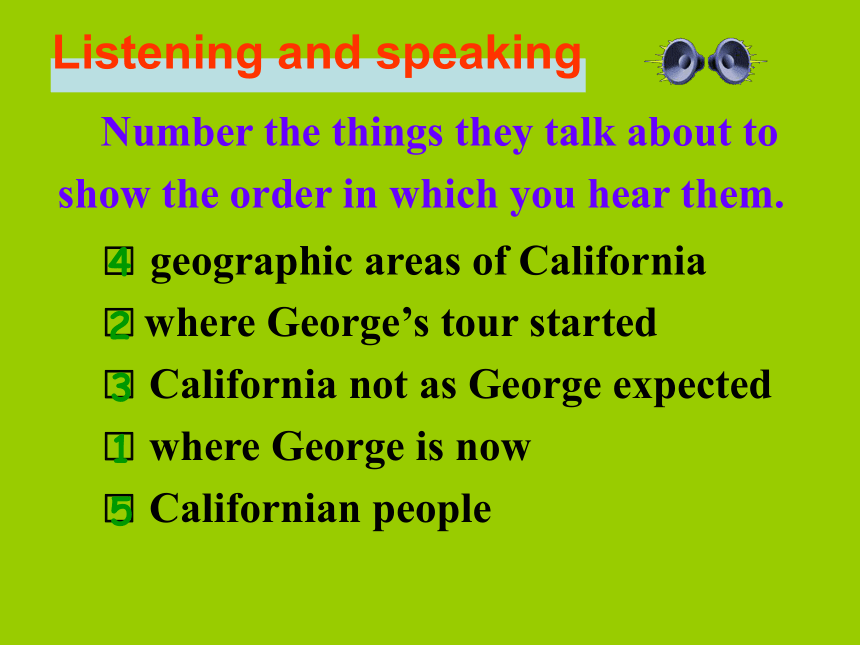
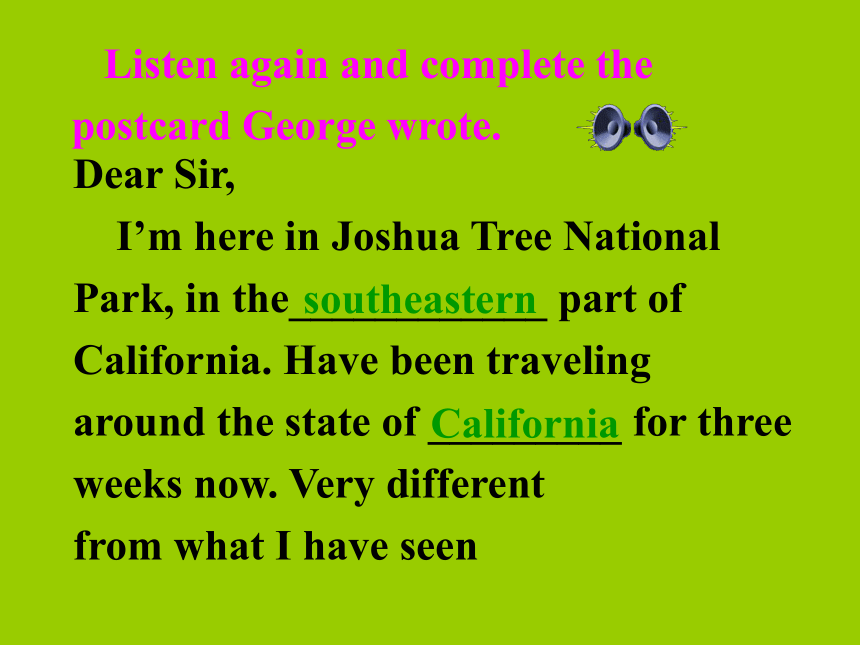
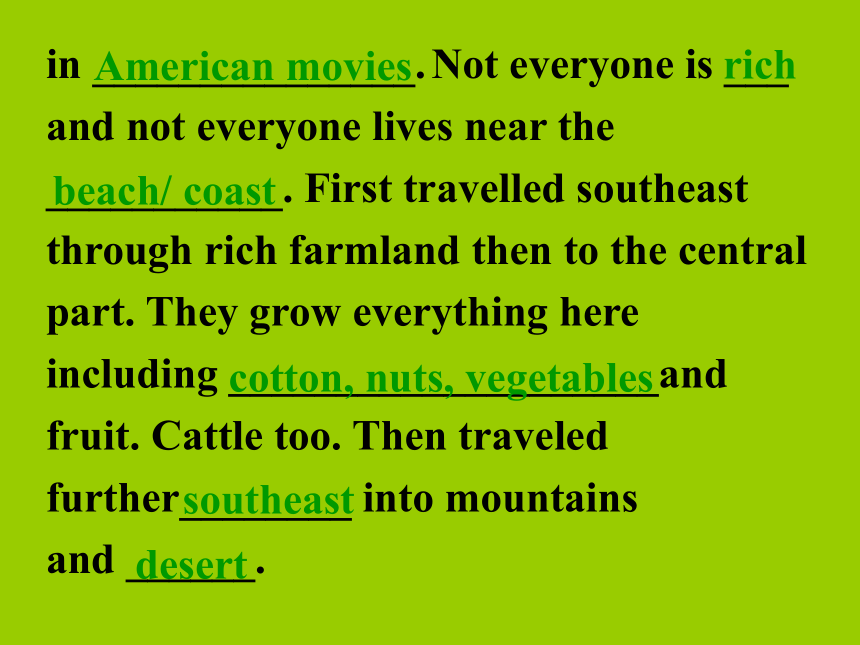
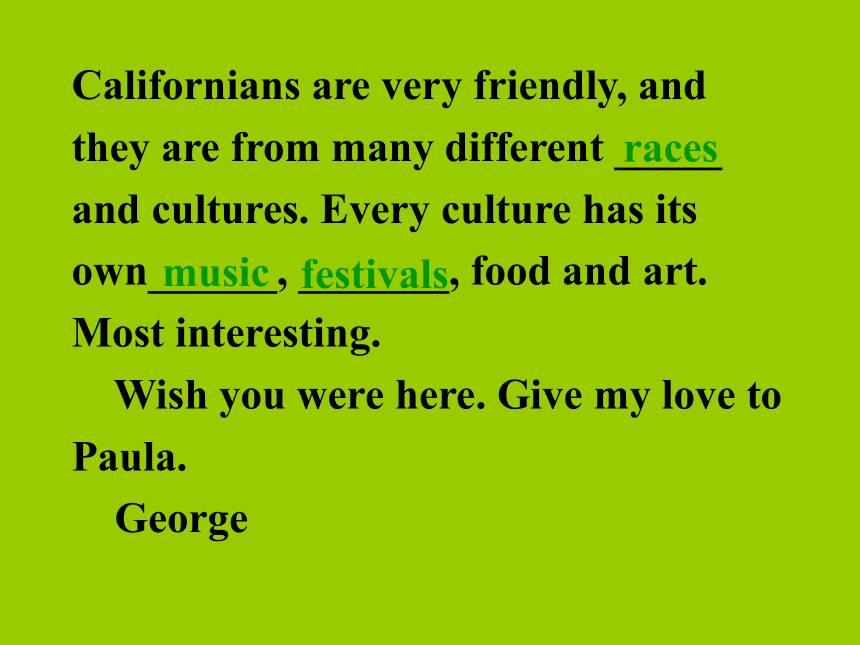
文档简介
课件79张PPT。Integrating Skills (I)Revision 1. A clause is called a noun clause when an entire clause takes the place of a noun in another clause or phrase.
I know that Latin is no longer spoken as a native language.
Where they are going is unknown.Sample answers to Activity 2:2. A clause is called an attributive clause when a dependent clause which takes the place of an adjective in another clause or phrase. Attributive clauses share conjunctions with noun clauses. What are the differences between them?Only refer to a personRefer to a person or a thingCan’t be omittedCan be omittedCan’t be omittedCan be omittedCan be omitted in the object clausesCan be omitted MeaninglessHave meaningsDon’t play a role in clausesPlay a role in clausesContaining meanings and functionsContaining meaningsCan’t be used Containing meanings; Only used in the predicative clausesContaining meanings and functions; can’t be omittedListening and speaking Number the things they talk about to show the order in which you hear them. □ geographic areas of California
□ where George’s tour started
□ California not as George expected
□ where George is now
□ Californian people12345 Listen again and complete the postcard George wrote.Dear Sir,
I’m here in Joshua Tree National Park, in the____________ part of California. Have been traveling around the state of _________ for three weeks now. Very different from what I have seensoutheasternCaliforniain _______________. Not everyone is ___ and not everyone lives near the ___________. First travelled southeast through rich farmland then to the central part. They grow everything here including ____________________and fruit. Cattle too. Then traveled further________ into mountains and ______. American moviesbeach/ coastrichcotton, nuts, vegetablessoutheastdesert Californians are very friendly, and
they are from many different _____ and cultures. Every culture has its own______, _______, food and art. Most interesting.
Wish you were here. Give my love to Paula.
GeorgeracesmusicfestivalsListening textA HOLIDAY IN CALIFORNIA
George is on holiday in the United States. He is touring around California. Listen to him phoning home to talk to his friend Christie.CHRISTIE: Hello.
GEORGE: Hi Christie. It’s me, George.
CHRISTIE: George! Where are you?
GEORGE: In Joshua Tree National Park.
CHRISTIE: Where’s that?
GEORGE: It’s in southeastern California. Not far from Palm Springs.CHRISTIE: What are you doing down there?
GEORGE: Well, I started in northern California and I’ve been travelling south.
CHRISTIE: Cool. So how’s the trip been?
GEORGE: Really great. There’s so much to see and it’s nothing like what I imagined.
CHRISTIE: Really?
GEORGE: Yeah. I expected everyone to live near the beach in big houses. And I thought everyone here would be rich.CHRISTIE: (laughing) You watch too many American movies.
GEORGE: I know, and they can give you the wrong idea!
CHRISTIE: So, tell me, what’s it really like?GEORGE: Well, some people live near the coast; but further east, in the central part, is a huge valley where they can grow all sorts of things like cotton and fruit, vegetables, nuts, oh lots of things. And lots of cattle.CHRISTIE: That’s interesting.
GEORGE: Mmm. And then as you go further southeast you come to mountains and desert. That land is really spectacular.
CHRISTIE: So you’re in the desert at the moment?GEORGE: Yes, that’s right. It’s very hot and very different from the rest of California.
CHRISTIE: I wish I could see it for myself. So what are the people like?GEORGE: Well, I didn’t realize there were so many different races and cultures here.
CHRISTIE: Such as?
GEORGE: Well, there are white and black Americans of course, and lots of Asians. And about a quarter of all Californians are Hispanic.CHRISTIE: Hispanic?
GEORGE: People whose ancestors came from Spanish speaking countries in South America.
CHRISTIE: Oh, I see.GEORGE: So there’s huge difference in culture and the way people look. Lots of different art, different types of festivals, music, food and anything else you can think of.
CHRISTIE: Sounds great. And what about …(fade out)Speaking (Activity 6 on page 7) Talk about traveling to some places
Where have you visited recently?
What is the climate like?
What did you think about the people? What other interesting things did you see?
That’s interesting / terrific / marvelous / cool / lovely!
You’re exciting / excellent.
Good / Creative /Fantastic / Super job!SingaporeJiuzhaigouPolite, well-educated, warm-heartedstaff's sense of environmental protectionHot and muggy; uncomfortablethroughout the year and temperatures here are extremely variable!?Chinese and Japanese gardens;
Chinatownthe transparent and multi-colored water in its lakes; Tibetan professional performanceSample dialogue: A: Where have you visited recently?
B: Singapore, a thriving independent city-state located just off the southern tip of the Malay Peninsula.
That’s marvelous.
A: What is the climate like?B: Hot, muggy and uncomfortable
A: What did you think about the people?
B: Polite, well-educated, and warm-hearted.
A: What other interesting things did you see?
B: I visited Chinese and Japaneselandscape. Their designs are embodied in these neighbouring gardens. The Imperial Sung Dynasty style is clipped to perfection within the 13-hectare (33-acre) Chinese Garden. It boasts the world’s largest Suzhou-style Bonsai garden outside of China, containing over 1,000 plants. The symmetry and simplicity of Zen aesthetics is the motif of the Japanese Gardens with its peaceful rock gardens and summerhouses.
A: That’s interesting. What else did you do?
B: I went to Chinatown, which is set against the backdrop ofSingapore’s modern infrastructure and the prosperous financial district.?The area is a receptacle of traditional Chinese customs. Yixing Xuan’s Teahouse provides a fascinating insight into the ancient, ritualistic art of tea-making while a visit to the Thian Hock Keng Temple leaves one in awe of Chinese traditions of worship and symbolism.
A: Fantastic job!Reading on page 7 Alcatraz island has served as a harbor fortification, military detention facility and maximum-security
federal penitentiary. The West Coast’s first
and oldest operating lighthouse is also
located on Alcatraz. Today Alcatraz is one
of San Francisco’s top tour attractions
that often sells out. cable car cable car and Alcatraz Known for its historic waterfront, delicious seafood, spectacular sights and unique shopping, Fisherman’s Wharf offers a wide array of things to do for everyone. Our fabulous location in the 'City by the Bay', puts
you within minutes of the
Maritime Museum, Alcatraz, Coit Tower and everyone’s favorite, the world famous San Francisco Cable Car lines. Fisherman’s Wharf offers some of the most incredible views of the
San Francisco Bay,
the Golden Gate Bridge
and the cityscape. The Golden Gate Bridge is a suspension bridge spanning over 1,280 meters to connect San
Francisco to the surrounding northern
Californian counties. The bridge was the
longest suspension bridge in the world at
the time of its completion in 1937 up
until 1964. The bridge stands 67 meters
above the water, with its towers reaching
227 meters above the water.Wednesday 14th, June Monday 12th, June Tuesday 13th, JuneTuesday 13th, June Write the day he saw these things.Wednesday 14th, June Monday 12th, June1. Why did Andrew Hallidie invent the cable car system?
He saw a terrible accident in which a tram slipped down the hill dragging the horses with it. So he invented the cable car system better and safer than horse-drawn trams.2. Where did George eat lunch on his first day in San Francisco?
She ate at Fisherman’s Wharf.3. Why did George hire a car? Why do you think he joined up with Terri and Peter?
It was cheaper to hire a car with other people because they could share the cost. Also he probably enjoyed being in the company of other tourists.4. Name three things that visitors can do in Chinatown.
Eat in Chinese restaurants, go to markets, visit temples and museums.5. What is Alcatraz Island famous for?
The island used to be a very harsh prison for the most dangerous prisoners. Rewrite the diary entry for Tuesday inserting all the missing words. On the next day, I teamed up with a couple from my hotel (Peter and Terri) and hired a car. We spent all day driving around city. There’s a great drive marked out for tourists. It has blue and white signs with seagulls onthem to show way to go. It’s a 79km round-trip that takes in all the famous spots. We stopped many times to admire the view and take photographs. Now we have really good idea of what the city’s like.
In the evening, I went to Chinatown with Peter and Terri. Chineseimmigrants settled in this area in the 1850s. The fronts of the buildings are decorated to look like old buildings in southern China. There are some interesting temples here, and a number of markets and a great many restaurants. Also there are art galleries and a museum containing documents, photographs and all sorts of objects about the history of Chinese immigration, but it’s closed in the evening. We will go back during the day. We had a delicious meal and then walked back down the hill to you hotel. 1. George is on holiday…
乔治在休假……Language pointsin/during the/one’s summer/winter holiday (s)
在暑假/寒假期间
in this holiday
今年暑假2. From top of the hill got a spectacular view of San Francisco Bay and the city.
从山顶上看到旧金山湾和城市的壮丽风光。辨析:view, scenery, scene, sight
view指从远处、高处看到的景象
scenery 指某地总的自然景观
scene指展现在眼前的景象
(是scenery的一部分)
sight指值得看的东西,某地特有的名胜 the beautiful scenery of the Three?Gorges
The?scene?after?the?earthquake?was?
horrible.
the?historical?sights?of?London
The?mountain?hotel?offered?
magnificent?views.3. Built in 1873, the cable car system was invented by Andrew Hallidie who wanted to find a better form of transport than horse-drawn trams.
缆车系统建于1873年,是由安德鲁·海利迪发明的,他试图找到一种比马拉轨道车更好的交通方式。horse-drawn 为n.+past. p→adj.
man-made 人造的
snow-covered 被雪覆盖的
state-owned 国营的
heartfelt 由衷的4. Apparently he’d been shocked when he saw a terrible accident in which a tram slipped down the hill dragging the horses with it.
显然当他看到一场事故中轨道车拖着马匹滑下山坡时大为震惊。(1) slip滑,滑倒,失足
A tram slipped of/from her hand.
书本从她的手中滑落。
(2) n. [C] 小错误
It’s normal for a young man to make a slip.
年轻人犯错误很正常。与slip相关的短语:
slip off 迅速脱去(衣服)
slip on 迅速穿上(衣服)
slip out 被无意说出
slip out of 迅速脱下(衣服)
slip sth. over on sb.
巧妙地捉弄某人,欺骗某人
slip up 犯错误,疏忽 In winter drivers have trouble stopping their cars from ___ on icy roads.? A. skating B. skidding
C. sliding D. slipping ? 在冬天,司机很难避免汽车在结了冰的路面上打滑。? skate表示“(在冰面上)滑行”、“溜(冰)”一般指滑冰运动;skid表示“(人、车等行进时因路面滑而向一侧)打滑,滑倒”;slide表示“(在冰、滑梯、跑道等上)滑行,滑动;滑落”;slip表示“失脚,滑跤”,常指由于不小心、路滑等而滑倒。根据句意,此处指“车轮的打滑”。?5. It’s also the place to catch the ferry to Alcatraz Island and other places in the Bay.
这也是乘渡船去恶魔岛和海湾其他地方的渡口。[名法分析] to catch the ferry to…in the Bay 为不定式作定语, 修饰the place。
不定式做定语时, 与所修饰的词之间有三种关系: 即动宾关系, 主谓关系和同位关系。6. Teamed up with a couple from my hotel and hired a car.
与我旅店里的一对夫妇结队而行并且合伙租了一辆车。 temp up (with)
与……合作或一起工作, 与……结成一队
Let’s team up!
我们联起手来吧!7. There’s a great drive marked out
for tourists.
有一条用线为游客画出界线的大道。drive n.
used in the names of roads 路, 大道
They live at 141 Park Drive.
他们住在公园路141号。take in
(1) 吸收,收留,收容,收养,接待
Our party branch took in a new
member yesterday.
我们党支部昨天吸收了一名新党员。8. It’s a 79 km round-trip that takes
in all the famous tourist spots.
正是这79公里的往返旅程包括了所有的著名的旅游景点。(2) 包括
This price takes in the cost of all
the accommodation and food.
这个价格包括了食宿等一切费用。
(3) 理会, 理解, 记住
I wonder if he’s really taking it in.
我想知道他是否真正明白了。(4) 欺骗,使上当
The salesman finds it easy to take
in old ladies.
这个推销员发现老太太容易上当受骗。
与take相关的短语:
take after 长得像
take apart 拆开,拆卸
take away 拿开,拿走 take back 收回,使回忆起
take off 拿走,取下,去掉;脱去;(使)离开;起跳(飞),(飞)机起飞
take on 承担,呈现,雇用
take over 接管,接替
take to 喜欢,习惯
take up with 和……交往,和……要好9. Some interesting temples here, a number of markets and a great many restaurants.
这里有一些有趣的寺庙、一些集市和许多饭店。“许多,大量”,
修饰可数名词修饰不可数名词修饰可数与不可数名词注意: (1) amounts of与quantities of后接不可数名词作主语时, 谓语动词用复数。
Large amounts of money are spent on tobacco every year.
每年都要花大量金钱在烟草上。(2) many a +(sing.) n. 作短语,谓语动词用单数。
Many a student wants to see the film Hero.
很多学生想看电影《英雄》。Homework Ask the students to finish Activity 5 on page 9.
I know that Latin is no longer spoken as a native language.
Where they are going is unknown.Sample answers to Activity 2:2. A clause is called an attributive clause when a dependent clause which takes the place of an adjective in another clause or phrase. Attributive clauses share conjunctions with noun clauses. What are the differences between them?Only refer to a personRefer to a person or a thingCan’t be omittedCan be omittedCan’t be omittedCan be omittedCan be omitted in the object clausesCan be omitted MeaninglessHave meaningsDon’t play a role in clausesPlay a role in clausesContaining meanings and functionsContaining meaningsCan’t be used Containing meanings; Only used in the predicative clausesContaining meanings and functions; can’t be omittedListening and speaking Number the things they talk about to show the order in which you hear them. □ geographic areas of California
□ where George’s tour started
□ California not as George expected
□ where George is now
□ Californian people12345 Listen again and complete the postcard George wrote.Dear Sir,
I’m here in Joshua Tree National Park, in the____________ part of California. Have been traveling around the state of _________ for three weeks now. Very different from what I have seensoutheasternCaliforniain _______________. Not everyone is ___ and not everyone lives near the ___________. First travelled southeast through rich farmland then to the central part. They grow everything here including ____________________and fruit. Cattle too. Then traveled further________ into mountains and ______. American moviesbeach/ coastrichcotton, nuts, vegetablessoutheastdesert Californians are very friendly, and
they are from many different _____ and cultures. Every culture has its own______, _______, food and art. Most interesting.
Wish you were here. Give my love to Paula.
GeorgeracesmusicfestivalsListening textA HOLIDAY IN CALIFORNIA
George is on holiday in the United States. He is touring around California. Listen to him phoning home to talk to his friend Christie.CHRISTIE: Hello.
GEORGE: Hi Christie. It’s me, George.
CHRISTIE: George! Where are you?
GEORGE: In Joshua Tree National Park.
CHRISTIE: Where’s that?
GEORGE: It’s in southeastern California. Not far from Palm Springs.CHRISTIE: What are you doing down there?
GEORGE: Well, I started in northern California and I’ve been travelling south.
CHRISTIE: Cool. So how’s the trip been?
GEORGE: Really great. There’s so much to see and it’s nothing like what I imagined.
CHRISTIE: Really?
GEORGE: Yeah. I expected everyone to live near the beach in big houses. And I thought everyone here would be rich.CHRISTIE: (laughing) You watch too many American movies.
GEORGE: I know, and they can give you the wrong idea!
CHRISTIE: So, tell me, what’s it really like?GEORGE: Well, some people live near the coast; but further east, in the central part, is a huge valley where they can grow all sorts of things like cotton and fruit, vegetables, nuts, oh lots of things. And lots of cattle.CHRISTIE: That’s interesting.
GEORGE: Mmm. And then as you go further southeast you come to mountains and desert. That land is really spectacular.
CHRISTIE: So you’re in the desert at the moment?GEORGE: Yes, that’s right. It’s very hot and very different from the rest of California.
CHRISTIE: I wish I could see it for myself. So what are the people like?GEORGE: Well, I didn’t realize there were so many different races and cultures here.
CHRISTIE: Such as?
GEORGE: Well, there are white and black Americans of course, and lots of Asians. And about a quarter of all Californians are Hispanic.CHRISTIE: Hispanic?
GEORGE: People whose ancestors came from Spanish speaking countries in South America.
CHRISTIE: Oh, I see.GEORGE: So there’s huge difference in culture and the way people look. Lots of different art, different types of festivals, music, food and anything else you can think of.
CHRISTIE: Sounds great. And what about …(fade out)Speaking (Activity 6 on page 7) Talk about traveling to some places
Where have you visited recently?
What is the climate like?
What did you think about the people? What other interesting things did you see?
That’s interesting / terrific / marvelous / cool / lovely!
You’re exciting / excellent.
Good / Creative /Fantastic / Super job!SingaporeJiuzhaigouPolite, well-educated, warm-heartedstaff's sense of environmental protectionHot and muggy; uncomfortablethroughout the year and temperatures here are extremely variable!?Chinese and Japanese gardens;
Chinatownthe transparent and multi-colored water in its lakes; Tibetan professional performanceSample dialogue: A: Where have you visited recently?
B: Singapore, a thriving independent city-state located just off the southern tip of the Malay Peninsula.
That’s marvelous.
A: What is the climate like?B: Hot, muggy and uncomfortable
A: What did you think about the people?
B: Polite, well-educated, and warm-hearted.
A: What other interesting things did you see?
B: I visited Chinese and Japaneselandscape. Their designs are embodied in these neighbouring gardens. The Imperial Sung Dynasty style is clipped to perfection within the 13-hectare (33-acre) Chinese Garden. It boasts the world’s largest Suzhou-style Bonsai garden outside of China, containing over 1,000 plants. The symmetry and simplicity of Zen aesthetics is the motif of the Japanese Gardens with its peaceful rock gardens and summerhouses.
A: That’s interesting. What else did you do?
B: I went to Chinatown, which is set against the backdrop ofSingapore’s modern infrastructure and the prosperous financial district.?The area is a receptacle of traditional Chinese customs. Yixing Xuan’s Teahouse provides a fascinating insight into the ancient, ritualistic art of tea-making while a visit to the Thian Hock Keng Temple leaves one in awe of Chinese traditions of worship and symbolism.
A: Fantastic job!Reading on page 7 Alcatraz island has served as a harbor fortification, military detention facility and maximum-security
federal penitentiary. The West Coast’s first
and oldest operating lighthouse is also
located on Alcatraz. Today Alcatraz is one
of San Francisco’s top tour attractions
that often sells out. cable car cable car and Alcatraz Known for its historic waterfront, delicious seafood, spectacular sights and unique shopping, Fisherman’s Wharf offers a wide array of things to do for everyone. Our fabulous location in the 'City by the Bay', puts
you within minutes of the
Maritime Museum, Alcatraz, Coit Tower and everyone’s favorite, the world famous San Francisco Cable Car lines. Fisherman’s Wharf offers some of the most incredible views of the
San Francisco Bay,
the Golden Gate Bridge
and the cityscape. The Golden Gate Bridge is a suspension bridge spanning over 1,280 meters to connect San
Francisco to the surrounding northern
Californian counties. The bridge was the
longest suspension bridge in the world at
the time of its completion in 1937 up
until 1964. The bridge stands 67 meters
above the water, with its towers reaching
227 meters above the water.Wednesday 14th, June Monday 12th, June Tuesday 13th, JuneTuesday 13th, June Write the day he saw these things.Wednesday 14th, June Monday 12th, June1. Why did Andrew Hallidie invent the cable car system?
He saw a terrible accident in which a tram slipped down the hill dragging the horses with it. So he invented the cable car system better and safer than horse-drawn trams.2. Where did George eat lunch on his first day in San Francisco?
She ate at Fisherman’s Wharf.3. Why did George hire a car? Why do you think he joined up with Terri and Peter?
It was cheaper to hire a car with other people because they could share the cost. Also he probably enjoyed being in the company of other tourists.4. Name three things that visitors can do in Chinatown.
Eat in Chinese restaurants, go to markets, visit temples and museums.5. What is Alcatraz Island famous for?
The island used to be a very harsh prison for the most dangerous prisoners. Rewrite the diary entry for Tuesday inserting all the missing words. On the next day, I teamed up with a couple from my hotel (Peter and Terri) and hired a car. We spent all day driving around city. There’s a great drive marked out for tourists. It has blue and white signs with seagulls onthem to show way to go. It’s a 79km round-trip that takes in all the famous spots. We stopped many times to admire the view and take photographs. Now we have really good idea of what the city’s like.
In the evening, I went to Chinatown with Peter and Terri. Chineseimmigrants settled in this area in the 1850s. The fronts of the buildings are decorated to look like old buildings in southern China. There are some interesting temples here, and a number of markets and a great many restaurants. Also there are art galleries and a museum containing documents, photographs and all sorts of objects about the history of Chinese immigration, but it’s closed in the evening. We will go back during the day. We had a delicious meal and then walked back down the hill to you hotel. 1. George is on holiday…
乔治在休假……Language pointsin/during the/one’s summer/winter holiday (s)
在暑假/寒假期间
in this holiday
今年暑假2. From top of the hill got a spectacular view of San Francisco Bay and the city.
从山顶上看到旧金山湾和城市的壮丽风光。辨析:view, scenery, scene, sight
view指从远处、高处看到的景象
scenery 指某地总的自然景观
scene指展现在眼前的景象
(是scenery的一部分)
sight指值得看的东西,某地特有的名胜 the beautiful scenery of the Three?Gorges
The?scene?after?the?earthquake?was?
horrible.
the?historical?sights?of?London
The?mountain?hotel?offered?
magnificent?views.3. Built in 1873, the cable car system was invented by Andrew Hallidie who wanted to find a better form of transport than horse-drawn trams.
缆车系统建于1873年,是由安德鲁·海利迪发明的,他试图找到一种比马拉轨道车更好的交通方式。horse-drawn 为n.+past. p→adj.
man-made 人造的
snow-covered 被雪覆盖的
state-owned 国营的
heartfelt 由衷的4. Apparently he’d been shocked when he saw a terrible accident in which a tram slipped down the hill dragging the horses with it.
显然当他看到一场事故中轨道车拖着马匹滑下山坡时大为震惊。(1) slip滑,滑倒,失足
A tram slipped of/from her hand.
书本从她的手中滑落。
(2) n. [C] 小错误
It’s normal for a young man to make a slip.
年轻人犯错误很正常。与slip相关的短语:
slip off 迅速脱去(衣服)
slip on 迅速穿上(衣服)
slip out 被无意说出
slip out of 迅速脱下(衣服)
slip sth. over on sb.
巧妙地捉弄某人,欺骗某人
slip up 犯错误,疏忽 In winter drivers have trouble stopping their cars from ___ on icy roads.? A. skating B. skidding
C. sliding D. slipping ? 在冬天,司机很难避免汽车在结了冰的路面上打滑。? skate表示“(在冰面上)滑行”、“溜(冰)”一般指滑冰运动;skid表示“(人、车等行进时因路面滑而向一侧)打滑,滑倒”;slide表示“(在冰、滑梯、跑道等上)滑行,滑动;滑落”;slip表示“失脚,滑跤”,常指由于不小心、路滑等而滑倒。根据句意,此处指“车轮的打滑”。?5. It’s also the place to catch the ferry to Alcatraz Island and other places in the Bay.
这也是乘渡船去恶魔岛和海湾其他地方的渡口。[名法分析] to catch the ferry to…in the Bay 为不定式作定语, 修饰the place。
不定式做定语时, 与所修饰的词之间有三种关系: 即动宾关系, 主谓关系和同位关系。6. Teamed up with a couple from my hotel and hired a car.
与我旅店里的一对夫妇结队而行并且合伙租了一辆车。 temp up (with)
与……合作或一起工作, 与……结成一队
Let’s team up!
我们联起手来吧!7. There’s a great drive marked out
for tourists.
有一条用线为游客画出界线的大道。drive n.
used in the names of roads 路, 大道
They live at 141 Park Drive.
他们住在公园路141号。take in
(1) 吸收,收留,收容,收养,接待
Our party branch took in a new
member yesterday.
我们党支部昨天吸收了一名新党员。8. It’s a 79 km round-trip that takes
in all the famous tourist spots.
正是这79公里的往返旅程包括了所有的著名的旅游景点。(2) 包括
This price takes in the cost of all
the accommodation and food.
这个价格包括了食宿等一切费用。
(3) 理会, 理解, 记住
I wonder if he’s really taking it in.
我想知道他是否真正明白了。(4) 欺骗,使上当
The salesman finds it easy to take
in old ladies.
这个推销员发现老太太容易上当受骗。
与take相关的短语:
take after 长得像
take apart 拆开,拆卸
take away 拿开,拿走 take back 收回,使回忆起
take off 拿走,取下,去掉;脱去;(使)离开;起跳(飞),(飞)机起飞
take on 承担,呈现,雇用
take over 接管,接替
take to 喜欢,习惯
take up with 和……交往,和……要好9. Some interesting temples here, a number of markets and a great many restaurants.
这里有一些有趣的寺庙、一些集市和许多饭店。“许多,大量”,
修饰可数名词修饰不可数名词修饰可数与不可数名词注意: (1) amounts of与quantities of后接不可数名词作主语时, 谓语动词用复数。
Large amounts of money are spent on tobacco every year.
每年都要花大量金钱在烟草上。(2) many a +(sing.) n. 作短语,谓语动词用单数。
Many a student wants to see the film Hero.
很多学生想看电影《英雄》。Homework Ask the students to finish Activity 5 on page 9.
